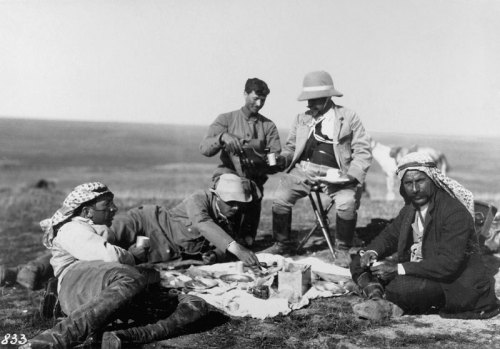
Without a doubt, archaeology is a colonial science (e.g., Effros and Lai 2018). In particular, the birth of “Near Eastern” archaeology—as it is still called today—revolves around the imperial awakening of European nations like France, Italy, Great Britain, and Germany during the late 19th/early 20th century.
Though specific individuals of that time might have had different motivations, that is, to prove the authenticity of the bible, or to accumulate extraordinary artifacts for newly established national museums and thereby gain some fame and influence, the discipline was always connected to notions of political interests in the region, to the feeding of orientalist thought, and to power struggles among European nation states.
In the course of the 20th century, the political situation of both Europe and the Middle East changed drastically, leading also to shifts and adjustments in archaeology. But the remnants of the formation of the field are still active today and difficult to overcome. We publish mostly in English, German, or French, only gradually moving towards abstracts and full articles in Arabic, Kurdish, and a little more so, Turkish. Military technologies like drones or satellite-imagery are often used without the consent of local communities (see Pollock 2016 for further detail). And even the way we present many of our data is obviously rooted in the thinking of borders and territories—there are hardly any archaeological publications without maps showing the extent of the empires or chiefdoms under study. As O. Hugo Benavides recently stated during a talk at the SAA Annual Meeting, archaeology is in fact not about the past, but about the present (similar see Benavides 2003). More specifically, it is about politics and the question of how we connect past and present, hence creating a past for our self-understanding. It is valuable to wonder why we still undertake this colonial endeavor, why we archaeologists want to deal with the past and also—after Foucault—what this doing does?
For me personally, a major part of being an archaeologist is exchange, travel, and sociology. In a healthy way, the discipline has lost its former allegedly greater political meaning (something some scholars still seem to refuse to acknowledge) and turned—at least partially—towards social theories that seek to understand both the socio-cultural structures of the past and their meaning and influence on the present. In this realm, archaeological projects started in recent years to study and consider the impact excavations have on the local communities they are based at—and vice versa (see Rosenzweig and Dissard 2013).
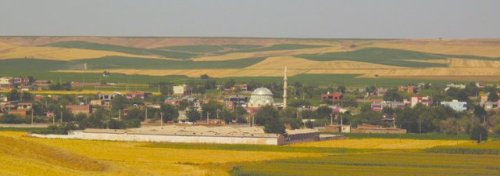
“View of the village of Tepe from the mound of Ziyaret Tepe” (Photograph by A. Wodzińska)
While only rarely the hierarchical dichotomy between workmen and -women on the one side and (foreign) researchers on the other can be overcome, I believe that already the awareness of the “excavation-doing” in a community that lives at or next to the archaeological remains is an important step towards acknowledging the two-sided endeavor each research project is, as well as the effect it has on all members involved.
With these broader thoughts in mind, I pondered about my life as a doctoral fellow at ANAMED in the heart of Istanbul. Many topics came to my mind, like the street musicians that are so much a part of our daily soundscape, yet being such strangers to us even after all this time; or the disappearance of Syrian forced migrants that were so present at Istiklal Caddesi just a few years ago, but have become almost invisible now.
Here, I want to dedicate this second part of my blog-entry to something seemingly more trivial. Having now lived for almost seven months in the Merkez Han building of ANAMED, I noticed an almost incidental “collaboration” established with the fellowship that had been going on between fellows and locals nearly unnoticed for years—a connection that goes quite literally under the skin: the gym. Working all day with the mind, a physical compensation is vital to maintain a healthy balance of the two. Just a ten minute, hilly walk away from ANAMED, at a lively corner of Cihangir, a group of fellows registered at a sports club and is using its facilities to do Pilates, Yoga, or “Total Body” workouts.
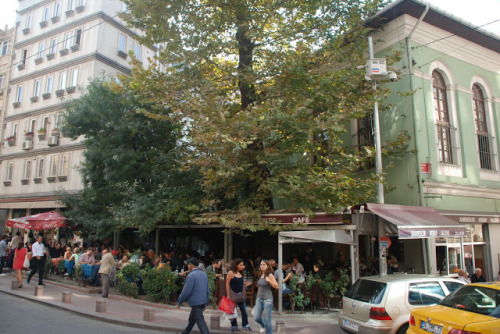
A lively corner in Cihangir, around the Firuzağa Cami” (photo by “Behlül’ün Gezi Rehberi)
As random or insignificant as this might sound, it literally shapes our bodies and hence our connection to the space we chose to temporarily live at. The buzzing backdrop of trashy electro-pop music, the smells of sweat and moving bodies, the Turkish instructions (“Nefes tutma!”), as well as the smiles and chats with familiar faces contribute to a sense of belonging and community.
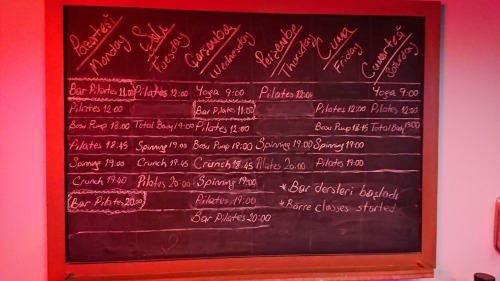
Weekly Schedule of the Gym
Of course, other than being an archaeologist that settles down in a village for a couple of months each year, we invade the gym as customers and as such possess a greater influence on the way we are treated and heard. As workwomen and -men on excavation, the position in regard to underlying power relations is not the same. Yet in both cases there is more to it than a simple “employer-employees” or “seller-customer” relationship. A space with room for exchange and interaction between otherwise unconnected people is created, laying the base for the possibility of benevolent mutual curiosity, personal growth—or just some fun.

Questionable Quote at the Gym’s entrance
For instance, each Thursday a handful of people meets in front of the gym and runs for an hour in the streets of Istanbul—to Maçka Park, the Golden Horn, up until the Marmara Sea. Everything you see, you hear, you experience, is shared with the ones you are jogging with. There is for example the young Turkish personal trainer, who is trying to become an actor, or the Turko-British writer that could talk for hours about languages, not to forget about one of the owners of the sports club, who revealed to me that ANAMED-fellows had been members of his gym for years now and therefore he knows exactly how long most of us are living in Istanbul and why we are here. While this is not part of the official agenda of the ANAMED-fellowship, it is worthwhile reflecting upon such small-scale encounters and the ways they become a part of the creation of somehow globalized subjects. When perceived and acted out self-consciously, it has the potential to set a subtle, miniature counterpart to the globally growing threat of nationalism and segregation. Apart from all this idealism—doing sports after a long day in ANAMED’s study room is also simply a lot of fun!
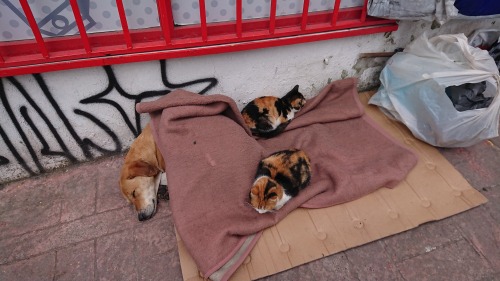
Street dog and cats on the way home to ANAMED—a motivator to relax too!
Bibliography:
Benavides, Hugo. 2003. “Seeing Xica and the Melodramatic Unveiling of Colonial Desire.” In ‘Social Text’ 76, 21(3), 109–34.
Effros, Bonnie and Guolong Lai, ed. 2018. ‘Unmasking Ideology in Imperial and Colonial Archaeology: Vocabulary, Symbols, and Legacy’. Los Angeles: Cotsen Institute of Archaeology Press, University of California, 2018.
Pollock, Susan. 2016. “Archaeology and Contemporary Warfare.” In ‘Annual Review of Anthropology’ 45(1), 215–31.
Rosenzweig, Melissa and Laurent Dissard. 2013. “Common Ground: Archaeological Practice and Local Communities in Southeastern Turkey.” In ‘Near Eastern Archaeology’ 76(3), 152–58.

